Live Debate on Voice of America with Kaveh Farrokh
The Tomb of Cyrus at Pasragardae has been the subject of a number of controversies to date (see below for details).
The most recent one pertians to questionable “restoration” methods that have been used by a local Iranian team led by Hassan Rahsaz. The latter was interviewed live along with Kaveh Farrokh in a televised debate at the Voice of America program “Meezgerd ba Shoma” (Roundtable with You) on December 29, 2008 (see interview clip below):
مصاحبه با دکتر کاوه فرخ و حسن راهساز درباره
وضعيت آرامگاه کورش در پاسارگاد
Farrokh noted in the interview that the only way to resolve the debates, questions and doubts is to allow neutral 3rd party non-governmental archaeologists and Iranologists from inside of Iran and abroad to visit the site and examine it up close (i.e. Professor David Stronach, Professor Richard Nelson Frye, etc.).
All other pertinent issues are also discussed and revisited in the items below.
The Sivand Controversy
There has been much controversy and discussion in recent years as to whether the construction of the dam of Sivand poses dangers to the site. Advocates of the dam state that no dangers exist, however this is not agreed upon by all experts, even in Iran. An organization in Iran known as Omedia has recently indicated that it may implicate the International Criminal Court for “crimes against humanity” due to potential destruction to Cyrus’ tomb.
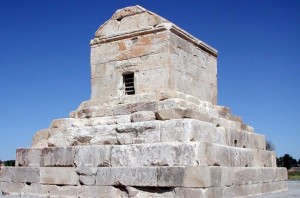
It is fairly certain that the construction of the dam will generate humidity than can cause damage to the nearby recently discovered palace of Darius the Great (549-486 BC) site of Tang e Bolaghi in the long term.
There is evidence that humidity has already begun to damage the site. See the photograph taken by the members of the Pasargard Heritage Foundation in Iran.
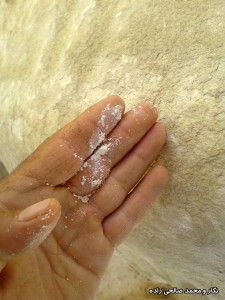
“Repairs” on the Cyrus Tomb: Where are the Italians?
The actual restoration of the tomb of Cyrus had been originally entrusted to a team of trained and experienced Italian researchers. Inexplicably however, these had been dismissed two years ago and substituted with an Iranian team (led by Hassan Rahsaz) who has been accused of having no credible training in archaeological techniques and restoration.
The Italian archaeological team has carefully and meticulously collected and packaged the stones around the site but it would seem that none of these were used used in the repairs.
In the aforementioned voice of America interview on December 29, 2008, Farriokh noted that the Italians had agreed to pay for the restoration of both Arg-e-Bam and Pasargard:themselves. This has been reported previoulsy by Iranian news sites such as Mehr, Etemad and Gooya.
“Repairs” on Cyrus Tomb: When did the actual reparis begin?
Hassan Rahsaz has cliamed that the work on the Cyrus site began 7 years (Mordad 1384). There are questions about this as it was only 4 years ago when Rahsaz made repairs proclamation along with UNESCO, with actual repairs begining just 3 years ago. The real issue however is how the restoration was conducted.
“Repairs” on the Cyrus Tomb: damage or restoration?
The issue however is not just whether the Sivand Dam poses a danger to Pasargardae and other heritage sites. In mid November Mehr News of Iran, Payvand news and the Shahrbaraz Blog reported that a part of the stone in the ceiling of Cyrus’ tomb had been removed and replaced with another piece of stone (and possibly mortar – detials await the UNESCO report). This was duly reported by an archaeological expert of ICHTHO (Iranian Cultural Heritage, Tourism and Handicrafts Organization). The expert, who asked to remain anonymous, told reporters that:
“Even natural factors such as wind and storms were not able to cause this kind of damage,”
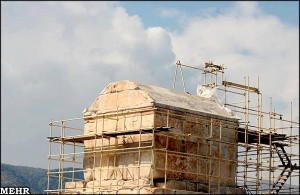
Photo from Mehr News. A portion of the ceiling has been replaced with crude restoration methods not in concordance with proper archaeological techniques.
The aforementioned ICHTO archaeological expert, who noted that the works by the Rahsaz team is “the kiss of death” further told reporters that:
“Rahsaz has learned restoration from on-the-job experience and he doesn’t have a relevant academic degree…During the project, he made many mistakes, the most important of which is related to the ceiling of the Tomb of the Cyrus the Great…While if the restoration of the ceiling was carried out based on scientific methods, it would have lasted in two years…”
The ICHTO expert noted that restoration of such sites must be done very slowly and meticulously by carefully and patiently repairing each piece of mortar and stone that have been separated from the monument over the centuries. This is in fact in concordance with scientific archaeological techniques.
The ICHTO report however is strongly disputed by Mohammd-Hassan Talebian (the director of the Parsa and Pasargadae Research Foundation – PPRF) who noted that:
“The restoration is one the best of its kind carried out in this country…A report containing details of the restoration project has been sent to UNESCO; if there was problem with the method used for restoration of the monument, they would certainly have notified us of a problem“
The restoration was reported as having been completed by November 28, 2008 by Iranian news agencies. It is still difficult It is hard to ascertain how the actual restoration has been done, without access to a complete and very technical report. It is fairly certain that the team did remove priceless pieces of ancient stone and simply replaced these with new ones. Even a UNESCO report would need to be supported and verified by their independent observers before arriving at a final conclusion.
Talebian refers to the fact that the restoration prevents rain from leaking into the chamber. However simply “plugging a leaky roof” is not a measure of archaeological prowess or success. What is certain is that the removed pieces of the stone of the tomb’s roof can certainly fetch a tidy sum in the markets, notably private collectors and enthusiasts.
What is fairly certain is that the situation in August 2007 was unfavorable at the site – a Lotus figure for example was damaged, and there are still questions pertaining to this. Interestingly, just two and one half months before the completion:of the project at the site, there was still ample evidence of much work that needed to be completed. Such works would have needed a much longer period (again) suggesting that plaster or cement may have been used to “hurry things up” (see photos shown earlier).
Some Photographs by the Pasargard Heritage Foundation
There is (literally) concrete photgraphic evidence that crude plastering methods have indeed been used for the “restoration” of the Cyrus tomb. Below are tow photographs taken by members of the Pasargard Heritage Foundation in Iran. Note the shades of the plaster and marled highlights pointing to these.
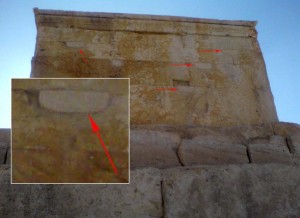
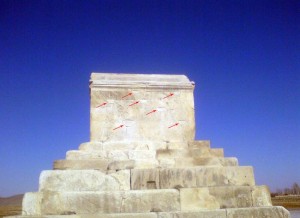
There are a number of other questions as well. Photographs taken in October 2007 by Negar and Mohammad Salehi-Zadeh (members of the Pasargard Heritage Foundation in iran) suggest that crude axe, chisel to Adze type instruments may have been used at the site. Note the photograph taken by the Salehi-Zadehs below.
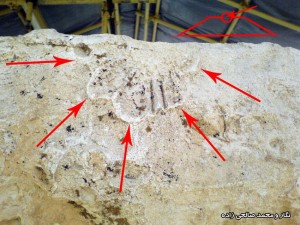
The metal frame built around the tomb may have inadvertendly damaged the site as well during the restoration process. See photograph below by the Pasargard heritage Foundation members in iran (Negar and Mohammad Salehi-Zadeh ) – note what appear to be large bullet holes.
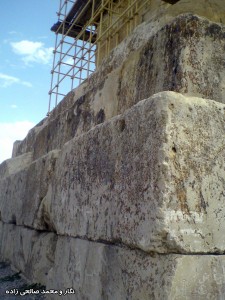
Barring a close-up inspection with the proper tools, one cannot ascertain why these holes have been created and when these impressions were made.
Were the right tools actually used?
It is possible that the wrong types of modern construction tools were used for the work on the Pasargard tomb. Two of the wrong tools to use for restoration of ancient sites such as the tomb at Pasargard are the following: an air hammer and the Adze.

An air hammer.
While the air hammer versatile for contemporary construciton, applicaiton of this upon old stobe-based structures such as the Acropolis, Colloseum or the Cyrus Tomb. This is becuase the shcok waves of this tool can cause very fine hairline fractures that can later develope into large cracks and eventually lead to the collpase and disintegration of the stone block. Interestingly Rahsaz mistakenly cited the above item as a nail-gun when in fact it is not.
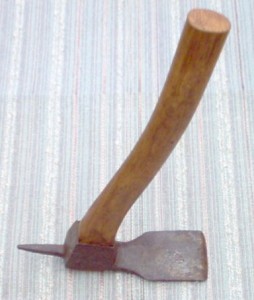 Adze or an axe with a inverted blade, known as “Teesheh” in iran.
Adze or an axe with a inverted blade, known as “Teesheh” in iran.
The Adze is certainly a useful tool but very crude if used for fine restoration works. This tool is primarly for breaking abnd chipping and unsuitable for restoration works.
Some typical tools for Excavation works
Restoration of ancient sites requires much time, patience and delicate and meticulous work by hand using finely crafted archaeological instruments such as the electronic digital caliper, campact scale, nylon grip drilling hammer, and a variety of other tools.

Electornic digital caliper

Compact scale
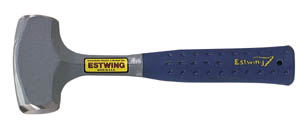
Nylon Grip Drilling Hammer
Below is a typical “basic” kit for the archaeologist.
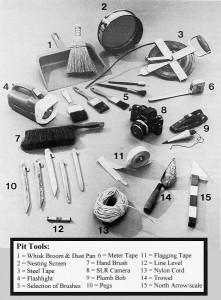
As noted previoulsy, restoration work is a delicate process which requires a gentle and professional approach. Note the archaeologist below engaged in restoring an ancient stone road.
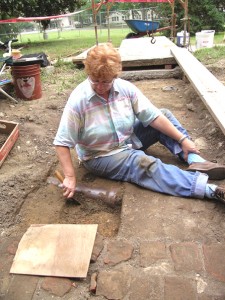
Note how gently pieces of stone, pebble and mud are removed. The archaeologist is as much an artist as she or he is a researcher.
Security arrangements and Professional access to the site
During the Voice of America interview on December 20, 2008, Hassan Rahsaz noted that the area has been barred from access by third-party and non-governmental archaeologists. The reasons given for this were “:security”. A contradiction was pointed out by the program host, Shayan Samii, who questioned as to why (given these security arrangements) “robbers” were able to come into the site with impunity and damage the roof (as Hassan Rahsaz said on the air).
The Advocates of Cyrus the Great in Iran: A Growing and influential Voice
Nevertheless, the situation in Iran is far from monolithic; in fact as noted already, there are many inside of Iran who work hard to preserve the ancient heritage of Cyrus. The Jaam e Jam News Service of Iran reported on November 24th 2008 that Rahim Mashayekhi, the Head of Iran’s Miraas e Farhangi (Cultural Heritage) delcared that Cyrus Day has now officially entered the national calendar of Iran. This is a clear indication that the advocates of Iran’s ancient heritage are growing in influence inside of Iran.



